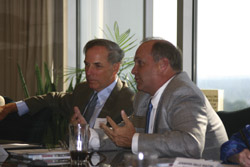
Legal Industry Outlook Chair Jack Kilroy explores the regulatory environment and discusses its affect on the legal profession and business community. Ingram’s Executive Editor Jack Cashill listens with interest.
Shaping the Regulatory Environment Jack Kilroy asked, “How do attorneys respond to an increasingly demanding regulatory environment?”
Joe Hiersteiner noted that one way in which lawyers help shape that environment is through the national organizations in which they participate. “We are continually commenting on regulation and advising those who make regulatory policy,” he noted.
Mike Burke cited the work that is going on in Jefferson City, where local attorneys are attempting to shape eminent domain and TIF issues “that will have a huge impact on cities.” Governor Matt Blunt has put a Blackwell Sanders partner on the eminent domain task force. “We have a lot to do with getting lawmakers to slow down and think about what they are doing,” said Dave Fenley.
Kim Jones spoke of her own work with the Missouri Human Rights Act. Mitch Woolery talked about his word with venture capital legislation as well as legislation to get birth certificates for children born in foreign countries.
John Granda added that attorneys share insights with their clients as to what regulators are looking for, namely strategies on crafting “not just what you have to live with but how you live with it.”
Complicating the regulatory issue of course is the state line.
“You get a real oddball result because of two states,” said Peter Brown with a smile. “If you die, you want to die in Missouri.”
John Murphy observed that corporations prefer Kansas because of legislation. There is pure comparative fault in Missouri but not in Kansas. He noted that good plaintiff firms have shut down their Kansas offices. “Clearly there are differences in personal injury litigation.”
Firms here have to work with two state houses, and that they do. “Part of their mission is to shape policy,” said Tom Stewart. One reason is to make it easier for clients to interface with government at all levels. A second reason, Stewart added, is “our obligation to the community.”
Susan McGreevey argued that legislatures are not so dominated by people from this area that can drive what happens in Jefferson City or Topeka. This means that the state line “does not help as much as it hurts.”
The observation was made that corporate attorneys who involved themselves with politics have historically emerged as Republicans on the Kansas side and Democrats on the Missouri side. “Not anymore,” joked Stewart. “We’ve all become Republicans,” laughed Dave Fenley.
“We make sure we have both in our firms,” said Susan McGreevey on a more serious note. “There it is,” added Fenley. “We have to be in tune with staffers at all different levels,” clarified Stewart.

Brian Finucane of Fisher & Phillips discusses the practicalities of arbitration. Susan McGreevy of Husch & Eppenberger notes the increase of litigious activity in the construction industry.
Avoiding Litigation
One way in which attorneys have been saving their clients time and money is by avoiding litigation when possible. Kent Sullivan argued that even firms that could afford litigation are going to mediation early, because it “provides a vehicle that works more often than not.” Jennifer Gille Bacon agreed that those who practice in state court know that it is “not the most efficient place to be.” Brian Finucane noted that employment law is moving to arbitration as a way of “precluding the courtroom.”
Clients also are pushing for early case assessment. Said John Murphy, “They don’t want cases ground into the earth.”
Anita Robb agreed. “Lawyers need to be looking at the long-term interest of their clients instead of a three-year income stream from the case.”
Tom Rice spoke of how he helped mediate a potentially fractious case involving an oil refinery explosion in a two-hour phone conference with five or six parties. The savings, he added, were “mind-boggling.” Craig O’Dear has been trying to emphasize conversation over email. “A phone call can avoid a lot of cost, a lot of headache.”
“It’s almost generational,” said Steve Brown. When he was coming up, there was a lot more face-to-face interaction between attorneys. Now, he is “working with younger associates to bring back the personal touch.”
In the construction arena, however, “there has been a big swing back to going to court.” So argued Susan McGreevy, who sees this move coming from the coasts by attorneys more interested in their own benefits than in the clients’.